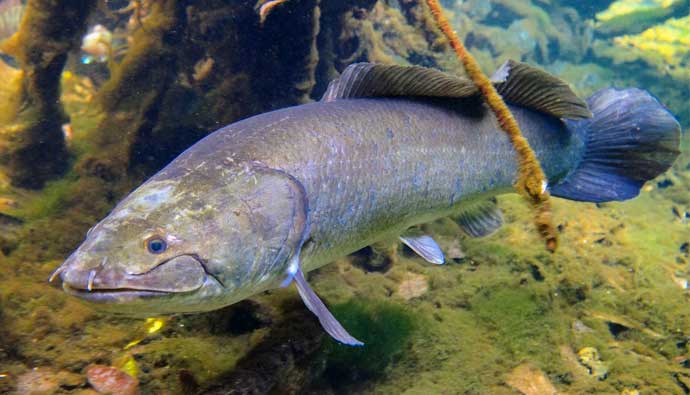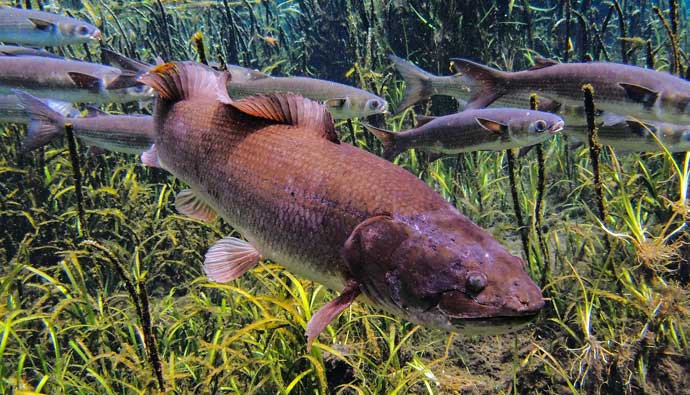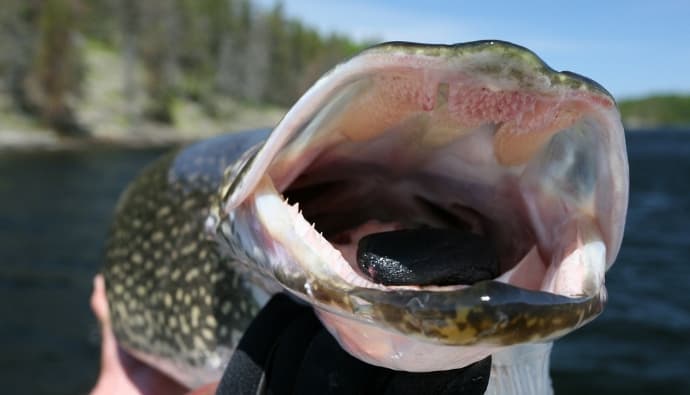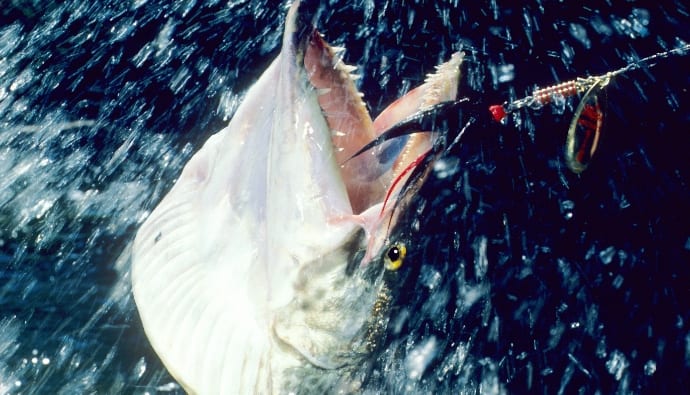To catch a bowfin, use medium-light or light rods. Bowfin like hiding in areas with lots of weeds. So first, locate their school. Bowfin is attracted to dead and live baits such as crayfish, shrimps, minnows, and nightcrawlers. You can also use larval salamanders as bait. If you prefer using artificial lures, bowfins are attracted to metallic minnow jigs, spinners, and crankbaits. Use size 3 to 3/10 circle hooks and a baitcasting reel to increase your chances of catching bowfin. They like hiding in shallow muddy waters, so after you cast out, set your drag to loosen until you get a bite. Use a 30-pound braided line and a wire leader that is about two feet in length to prevent them from tearing through the line and carry your bait or lure.
Bowfin fish are quite aggressive and can strike both subsurface and topwater presentations. Knowing how to catch them will spare you from spending hours trying to locate them and induce a bite. Here is how you can catch a bowfin without much hassle.

Recommended Bowfin Fishing Gear:
- Rod: Kastking Perigree II
- Reel: Kastking Sharky III
- Hooks: Gamakatsu Octopus Circle Hooks
Overview
The bowfin fish is a freshwater fish can be found in sluggish North American waters that range from the Great Lakes, North Carolina, all the way to the Gulf of Mexico.
Bowfin fish is also known as mudfish, beaverfish, alcaraz, marshfish, mud pike, swamp trout, griddle, dogfish, and choupique. This freshwater fish can breathe air as well as underwater, which is why they can also be found in low-oxygen waters. It is also the only living survivor of a group of fish whose fossils date back to the age of the dinosaurs!
The freshwater dogfish or bowfin fish has a long elongated body and is almost entirely cylindrical with a long dorsal fin that extends from the middle of the back down to the tail. It has a distinct black spot on the upper base of the tail, which is meant to confuse predators. The mouth is large and is filled with several sharp teeth.
Bowfin Facts
| Scientific Name | Amia calva |
| Common Name(s) | Bowfin, mudfish, mud pike, beaverfish, alcaraz, marshfish, swamp trout, griddle, dogfish, and choupique |
| Family | Amiidae |
| Identifying Characteristics | It has a long elongated body and is almost entirely cylindrical with a long dorsal fin that extends from the middle of the back down to the tail. |
| Depth Range | 61 to 92 m |
| Habitat | It can be found in the sluggish North American waters that range from the Great Lakes to the Gulf of Mexico. |
| Limits | Check your local regulations |
| Largest Recorded | 21 lbs 8 oz |
Where to Catch
Bowfins can usually be found in lowlands in brackish water, clear and vegetation-rich streams, and oxbow lakes. The fish prefers clear water that has enough vegetation that it can hide in, but it can tolerate a bit of mud and silt.
Adults can be found deep underwater, but they venture out in the shallows at night during the breeding season. They can also be found in submerged roots and logs.
Two words that speak volumes about catching bowfin, especially the big ones is dogfish Ontario…Canada sports some good size bowfin if you venture up that way.
How to Go Catching Bowfin

The bowfin fish is not lightweight, but you need to have a light touch to hook them. The fish is quite aggressive and will strike both subsurface and top-water presentations, so you don’t need to be picky with the tackle.
In general, medium-light rods or light rods are the best choices for catching bowfin. Look for it in areas that have a lot of weeds, such as bogs.
It will bite at both dead and live fresh bait such as shrimp, crayfish, nightcrawlers, minnows, or shad but you can also use larval salamanders.
If you prefer to use artificial lures, you can use any bass fishing lure, such as spinners, minnow jigs, and crankbaits. Just make sure they are made of metal. The fish has very sharp teeth that do short work on soft plastics.
One common bait used in New Jersey a lot is sunfish cut bait. Throw on a size that works well with the hooks you are using. Remember small bait, small hooks, and big bait, bigger hooks. If you’re allowed more than one rod in the water, then it’s a good call to try different size hooks to see what they bite.
Use these tips below so you can land some large bowfin fish.
Bowfin Fishing Methods and Tactics
- Bowfin amia calva jaws can be tough to penetrate, so make sure that you use big hooks that can hold up. Size 3 to 3/0 circle hooks will work better than J hooks.
- For this game, fish using a baitcasting reel so that you have more accuracy and can cast heavier lures and baits.
- Since you’re bowfin fishing in shallow muddy waters, you’re going to need to watch out for turtles. They tend to go after the same bait and hang with bowfin.
- Bowfin mouths are bony and plated, so it’s not uncommon to miss the hook set. Make sure you set the hook with force if you’re using a J hook.
- Bowfin tends to just hang around the bottom as they are scavenging for the dead decaying matter.
- After you cast out, set your drag to loosen until you get a bite. Once you feel the bowfin bite, then tighten the drag, reel in until the line is taught, then set the hook.
- Catching bowfin is nearly identical to catfishing. If you have fishing methods that work for you in your area, then try them out.

Fishing Tips
- Use a 20 to 30-pound braided line when you are fishing for mudfish. This will give you sufficient heft to handle the most aggressive one, and the stiff line will also help in setting the hook. It’s also durable enough to remain intact if it snags around submerged logs and rocks.
- A wire leader that is about 1 to 2 feet in length will prevent bowfin from tearing through the line and stealing the bait or lure.
- Bowfin isn’t super complicated to land. However, the challenge comes from finding them. Once you find the ideal waterway, it’s simply putting out cut bait and waiting for a hookup. It is good to move your bait from place to place if you aren’t getting bites within a few minutes.
- Moving from place to place and being an active angler is beneficial until you find a spot where the bowfin congregates.
Seasons
The best time for catching bowfin is when it is spawning between April and June. That is when this prehistoric fish comes up to the shallows to breed and build nests.
Bowfin doesn’t do anything special while spawning, like building a nest. They tend to have the females lay their eggs in one spot. The male bowfin will then come by and fertilize.
How to Clean
The secret to having good-tasting bowfin meat is keeping it alive until you’re ready to clean it. That’s because the flesh is soft, and you don’t want it to spoil or have an off-putting flavor. What seems to prevent this is having freshwater bowfin that can be cooked quickly after the fish has been killed.
Bleeding It First
After you’ve killed the bowfin either by braining it or knocking it upside the head, you’re going to want to bleed it out. To bleed it out, puncture your knife to break the backbone near the tail. Once you have the hole, you’re going to use your hand to push the blood from the body and out the tail.
To check that the bowfin is properly bled, you’ll need to check the gills to see that the deep red has gone down to more of a pinkish color. If you don’t bleed the fish then the bowfin will have a rough taste.
Another way to bleed is to cut the gills and place the fish in a bucket of water to have the blood pull out.
Remove the Scales
After the blood has been removed, use the newspaper to remove the bowfin slime since they are slimy fish.
Scale the mudfish as soon as you catch it using either a butter knife or a scraper, or skin the fish completely if you want to avoid scaling. Since the bowfin skin is soft, the latter is the preferred method. Use the newspaper to hold the head of the fish while you cut the scales off with your knife.
Gut the Fish
One thing to remember when cleaning a bowfin is to make sure that you don’t spill the innards on your meat. If you do it correctly, you can remove the head and pull the entire guts out without having to cut open the bottom of the bowfin cavity.
So to start this, use a sharp knife and start cutting behind the pectoral fins. Cut about half an inch into the flesh and move the knife upwards towards the bowfin head right up to the lower jaw.
Reach into the exposed cavity and pull out the guts of the fish at the base of the head. Use your knife to pull as much out as you can.
Apparently, if you find roe in the bowfin, it’s actually considered a delicacy in Louisiana.
Scrape out the swim bladder and the liver, which are located at the center of the bowfin and the backbone.
Cut off the gills, the head, and the tail completely.
Cut off fillets from the fish quickly and put them on ice till you get back to shore or home. The fresher you can keep the fillets, the better they will taste.
How to Cook Bowfin
Bowfin is mostly considered a trash fish but it can taste good if cooked correctly.
Recipe
Turn the bowfin into one of the best tasting fish with this recipe. Make sure that the fillets you use are fresh, or the fish will ball up in your mouth like cotton and taste just as nasty.
If you want to mix the fillets into potatoes to make patties, here’s a good recipe for it.
- Chop the fillets into small pieces till you have 3 cups worth of bowfin meat.
- Combine the meat with 1 cup of mashed potatoes, 1 lightly scrambled egg, ¼ cup of flour, ¼ cup of chopped white onion, ½ chopped green onion, ¼ cup of parsley, and salt and cayenne according to your taste.
- Place 4 tablespoons of flour in a shallow dish and pat your hand in it before rolling the mixture into egg-sized balls.
- Refrigerate the bowfin patties for an hour.
- Fry in hot oil till golden brown.
Another method of cooking, especially popular in parts of North America, would be to bake and fry the fillets. Take your fillets and coat them in whatever egg-based batter you desire. Instead of frying them, place the fillets in a baking pan.
Spray or drizzle some oil on the top size of the fillets and put them in the oven. Cook them on parchment paper in the oven at 425 degrees for 15-20 minutes. Then check them and if they are looking good, then flip them over and cook for another 15-20 minutes.
They should come out nice a crispy without being soaked through with oil.
Frequently Asked Questions
While most anglers consider bowfin to be a trash fish, it can actually taste pretty good if it is cooked immediately after it is caught.
The bowfin is an ambush predatory fish that preys on frogs, crayfish, mollusks, and aquatic insects. Young ones eat insects and microscopic organisms.
The maximum lifespan of this fish is 10 years, but captive ones have been known to live for 30 years.
Insider Advice
The best way to catch bowfin is by bringing a few rods and reels with you with various setups. Leave them in the water and see which bait is working best. A lot of times you’ll be treating this type of fishing the same way you’d go for catfish. You can leave the drag loose or even keep it open bail.
Wait for the fish to take your bait and set the hook. If you’re using circle hooks, you won’t need to worry about setting the hook as much.
Since they are scavengers, you’ll likely be able to get them on nearly any size hook, but we like to use the smallest hook for the job.




 Facebook
Facebook YouTube
YouTube








